Objectives:
Before proceeding to the “MeSH search practice” and “MeSH search correction video” portions of today’s session, I want to give you some important MeSH search tips. These tips are based on the way MEDLINE is indexed. These may not make sense immediately, but don’t despair. I will explain and provide examples.
- Consider using a floating subheading
- Remember that MeSH indexing is disease-focused
- Use broad subheadings
- Try searches with and without subheadings.
- Only use a subheading if it’s important to focus on a specific aspect of a topic
I’ll use stories of searches that were requested during my early career to illustrate these points.
_________________________________________________________________________________
Tip 1. Consider using a floating subheading
Example 1:
During the early years of my career as a librarian, I was asked for articles that focused on endoscopic pituitary surgery methods. I started with the following MeSH search:
“Pituitary Gland/surgery”[MeSH] AND “Endoscopy”[Mesh] AND “methods” [Subheading]
“methods” is a floating subheading.
A floating subheading will retrieve any record with that subheading regardless of the heading the indexer actually used with the subheading. I didn’t know what type of methods would be mentioned — endoscopy methods, anesthesia methods, hemorrhage control methods , etc. — I just knew that I wanted articles that focused on methods.
The process of adding a floating subheading to a search is no different than adding a heading to a search. Both can be located by searching the MeSH database, selected, and added to the search using the “Add to Search Builder” button.
The “methods” floating subheading was helpful. My results were focused on pituitary surgery methods. However, when I compared my search results to the results of a quick keyword search, I found that I had missed many relevant MEDLINE records. Then I remembered —
_________________________________________________________________________________
Tip 2. MeSH indexing is disease-centered
When an article can be indexed as being about a disease or group of diseases, it will be. Most articles about pituitary surgery methods are indexed as being about surgical treatment of a specific pituitary disease/s. Only the articles about surgical methods that are not targeted at a particular disease (but pituitary surgery in general) are likely to get the “Pitutiary Gland/surgery” heading/subheading combination. Those focused on a specific pituitary condition will be indexed with that condition’s headings and the surgery subheading (for example: “Pituitary Apoplexy/surgery”). All of the specific pituitary disease headings will be retrieved by a search for “Pituitary Diseases”[MeSH]. I revised my search strategy:
(“Pituitary Diseases/surgery”[MeSH] OR “Pituitary Gland/surgery”[MeSH] ) AND “Endoscopy”[Mesh] AND “methods” [Subheading]
__________________
Example 2:
At another time I needed to search for articles about weight loss diets. There’s a good heading for weight loss diets —
“Diet, Reducing”[Mesh]
I again found that a search using this heading was missing a lot of relevant MEDLINE records. Why? It wasn’t a heading introduction date problem. The “Diet Reducing”[MeSH] heading was introduced into the MeSH vocabulary before MEDLINE existed in online form.
Eventually, I found that most of the other relevant articles were indexed as articles about treatment of obesity using either
“Obesity/diet therapy”[MeSH]
or
“Obesity/therapy”[MeSH]
The history table below shows that the sets of records retrieved by “Diet Reducing”[MeSH] and “Obesity/diet therapy”[MeSH] overlap but are not identical.
![A screenshot shows that the number of results of a search for "Diet, Reducing"[MeSH] OR "Obesity/diet therapy"[MeSH] is much greater than the number of results retrieved by each of the terms separately.](https://pressbooks.nebraska.edu/app/uploads/sites/77/2020/07/obesity-diet-1024x358.jpg)
I mentioned that some of the relevant records retrieved by the keyword search were indexed with “Obesity/therapy”[MeSH] rather than “Obesity/diet therapy”[MeSH] . Can you guess why this is true? An explanation brings me to my next point —
_________________________________________________________________________________
Tip 3. Use broad subheadings when applicable
The “therapy”, “therapeutic use”, “adverse effects” , and “etiology” subheadings recommended by two of the search templates are ‘broad’ subheadings. All four have narrower subheadings that may be applicable to your search and will be sitting there in the list of subheadings, saying, “pick me, pick me” every time you build a MeSH search. The reason you should remember the broader subheadings is explained below:
__________________
“Therapy” subheading
Here’s the MeSH tree for the “therapy” subheading:
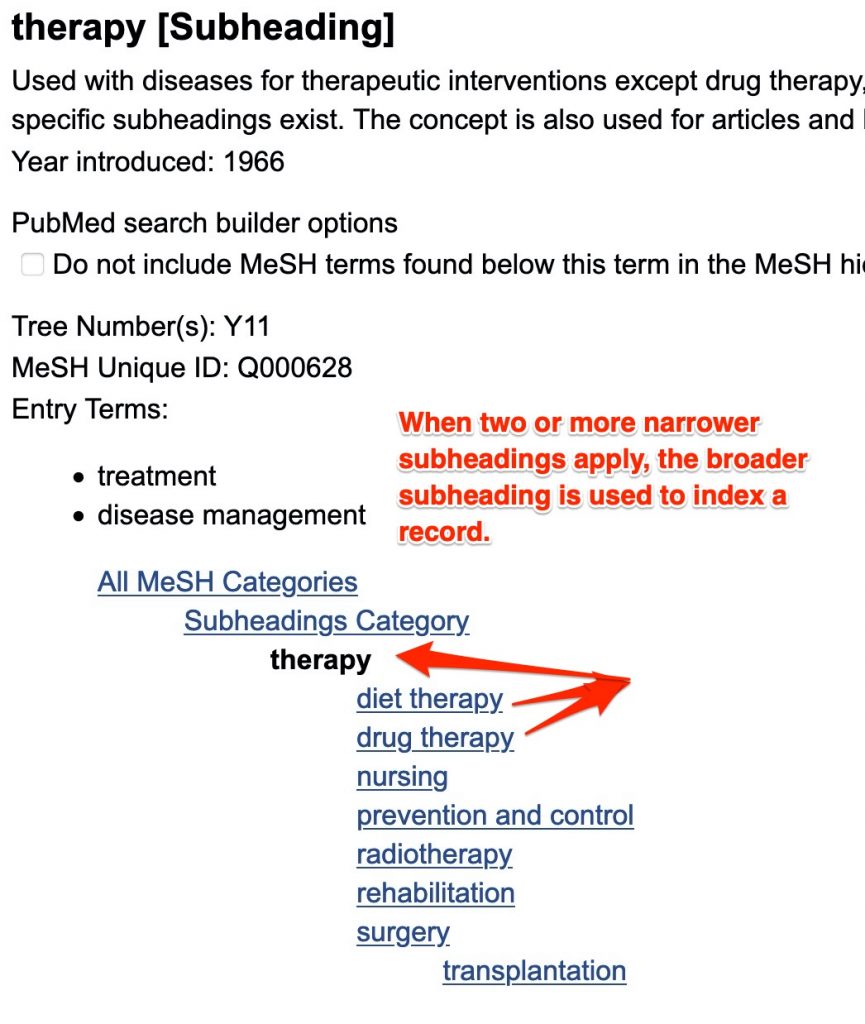
In general, indexers only apply one subheading from a particular subheading tree. If an article covers two different types of therapy — drug therapy plus massage, drug therapy plus diet therapy, etc — the indexer will use the broad “therapy” subheading. If you want to retrieve these multi-modality therapy articles you will need to use the “therapy” subheading rather than the “drug therapy” subheading.
Think twice before using a “_________/drug therapy” heading/subheading combo alone!
In PubMed, subheadings are always ‘exploded’ a search for a heading in combination with the “therapy” subheading will retrieve any records indexed with the chosen heading (or narrower headings) with either the therapy subheading or any narrower subheading ( including the “drug therapy” subheading). Of course, when you use the “therapy” subheading you could retrieve articles about “diet therapy” that don’t mention drug therapy. However, your searches will often have a separate drug concept that will help focus your search.
__________________
“Therapeutic use” subheading
Here’s the “therapeutic use” tree:
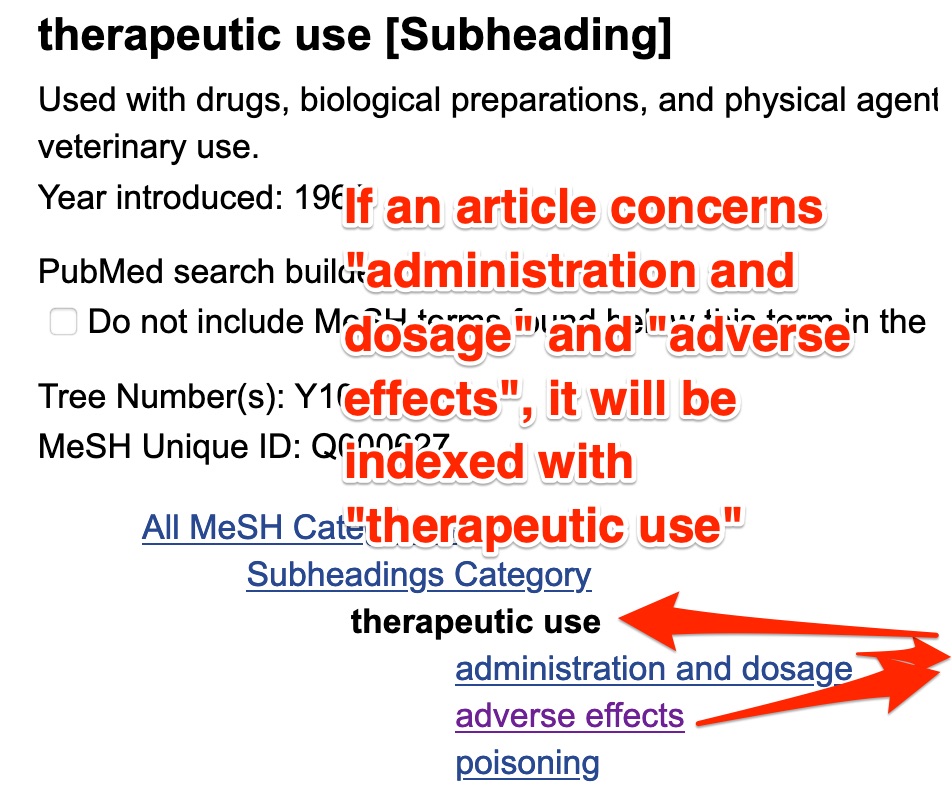
In general, avoid using a “______/administration and dosage”[MeSH] combination alone. Instead use the broader “_________/therapeutic use”[MeSH] (or use both heading/subheading combinations OR’d together).
Remember, PubMed will explode the “therapeutic use” subheading. A heading in combination with the “therapeutic use” subheading will retrieve any record indexed with the chosen heading (or a narrower heading) in combination with the “therapeutic use” subheading or a narrower subheading.
__________________
“Etiology” subheading
Here’s the “etiology” subheading tree:
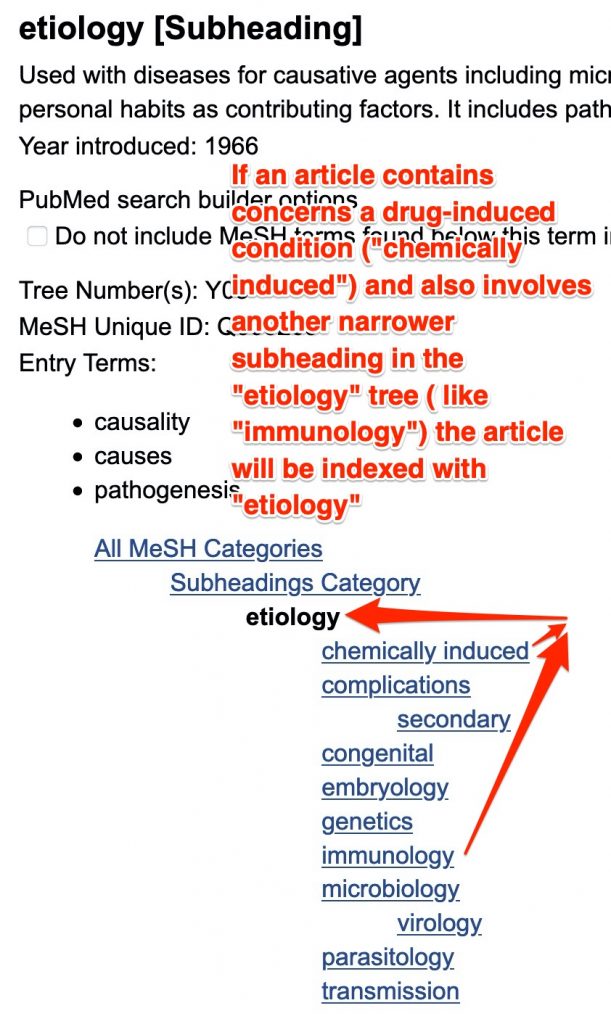
In general, avoid using a “____________/chemically-induced”[MeSH} combination alone. Instead use the “_____________/etiology”{MeSH] combination or use both heading/subheading combinations OR’d together.
__________________
“Adverse effects” subheading
Here’s the “adverse effects” subheading tree:
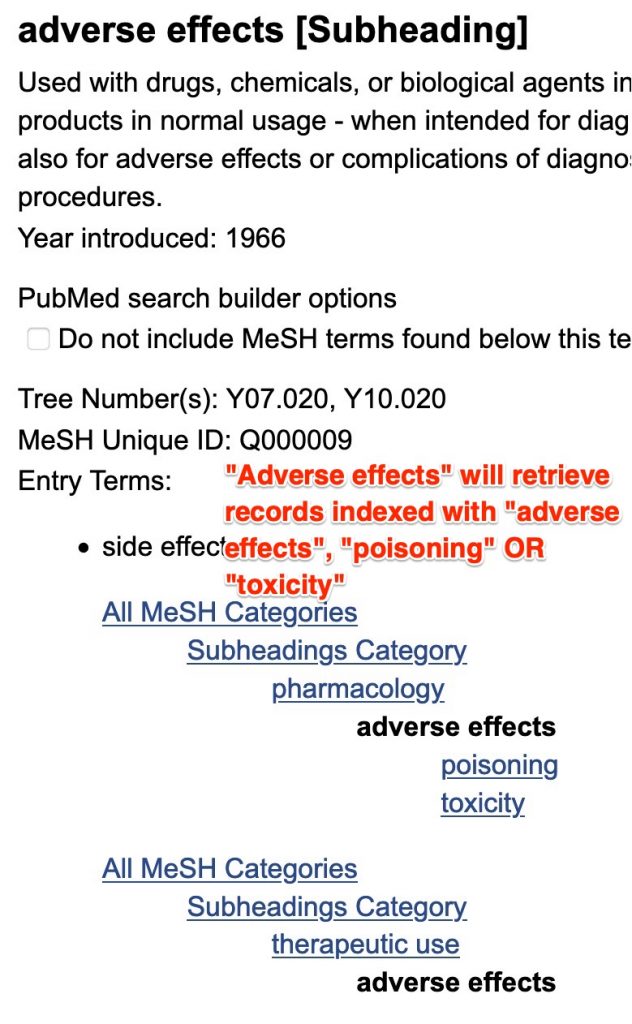
In general, do not use the “_____________/toxicity”[MeSH] combination alone. Instead use the “_______________/adverse effects”[MeSH] combination or both heading/subheading combinations OR’d together.
_________________________________________________________________________________
Tip 4. Try searches with and without subheadings.⭐
There are several reasons to try removing the subheadings form a MeSH search. All you need to remember is that it’s worth trying MeSH searches with and without subheadings.
For those who want the reasons it is worth trying a search without subheadings:
- Some headings have not always been headings, but have a spent a portion of their ‘lives’ in the MeSH database as “Supplementary Concepts” . Supplementary Concepts are unofficial headings that don’t have subheadings. When a “Supplementary Concept” becomes an official MeSH heading, all instances of the “Supplementary Concept” are changed to the new MeSH heading but subheadings are not added. This leaves a lot of indexed records with no subheadings. New drugs are usually represented by “Supplementary Concepts” for years before that ‘powers that be’ decide an official MeSH is needed. It’s especially important to try removing subheadings you’ve used in combination with drug headings.
- MEDLINE indexers are only allowed a limited number of subheadings (~3) with each heading. If more subheadings apply to an article’s subject matter, the indexer must use the heading without subheadings.
- An indexer may use an expected subheading with a heading different than the expected heading.
Example of a record that was not indexed in the way I expected:
Title:
-
- “A randomized controlled study for Yuanhu Zhitong dropping pills in the treatment of knee osteoarthritis”
Indexing I expected:
-
- “Osteoarthritis/therapy”
Actual indexing:
-
- “Arthralgia/drug therapy” (joint pain therapy)
- “Osteoarthritis, Knee / complications”
_________________________________________________________________________________
Tip 5. Only use a subheading if it’s important to focus on a specific aspect of a topic
Let’s say you need to do a search for articles about using methotrexate to treat rheumatoid arthritis in patients with kidney failure. Part of the search is a “using a drug to treat a disease” search. I’d be planning
methotrexate heading plus therapeutic use subheading
AND
rheumatoid arthritis heading plus therapy subheading
AND
kidney failure
Do you want a subheading with kidney failure? Students tend to look at subheadings every time they add a heading. Remember, the heading without a subheading will retrieve anything indexed with that heading with or without subheadings. If you don’t need to focus on an aspect of a topic, don’t add a subheading!
_________________________________________________________________________________
Practice and Assignment Correction
You’ve now done a bit of MeSH searching. You’ve used templates to help you plan MeSH searches for :
- a drug used to treat a disease
- a disease caused by drug adverse effects
and are aware of the template for
3. a drug used to prevent a disease
You will be confronted with these three types of searches often during your careers, and I would prefer that the heading/subheading combinations suggested by the templates make sense to you, that they become second nature. As you complete the exercises below, you’ll get some more practice with the these three types of searches. Hopefully, the templates will begin to seem like the logical/easy choice. (You’ll be provided the templates on the exam, but shouldn’t really need to consult them.)
__________________
Recite the templates out loud
If you were sitting in class with me, I would make you all recite the bold faced info below several times as a class. I’ve heard that speaking can serve to reinforce memory. I suggest you whisper or speak the bold-faced information below:
Drug causes a disease = adverse effect of a drug is the cause (etiology) of a disease =
drug/adverse effects AND disease/etiology
Drug treats a disease = therapeutic use of a drug is the treatment for a disease =
drug/therapeutic use AND disease/therapy
Drug prevents a disease = drug is used for prevention of the disease =
Drug AND disease/prevention and control
__________________
Practice using the templates
To practice, use the MeSH database to construct searches for the topics listed below. It’s difficult to focus on these topics if you don’t use heading/subheading combinations.
__________________
Correct last week’s assignment
You may remember that the topic of the last exercise above was the topic of the first assignment you completed last week. You may have refined the search and OR’d the “Kidney Diseases/mortality”[Mesh] heading/subheading combination into the “kidney diseases” concept. Check your work on that assignment to be sure you understand the correct approach.
The process of completing last week’s second assignment (the MeSH search for your final search assignment) is demonstrated in the video below. Please, review your work on that assignment while watching the video.
| Required video focused on correcting FSA3 | 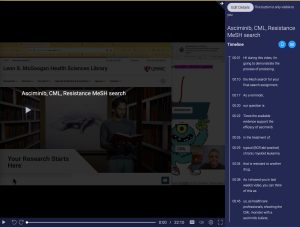 |
_________________________________________________________________________________
Assignment
- Watch the linked video above.
- Either;
a) Find and list the errors in your own assignment. Then correct your search strategy and run the search again in PubMed.
b). Work with a classmate’s search or the errant sample search below. Find and list the errors. Then correct the strategy.
errant sample search:
“Leukemia, Myelogenous, Chronic, BCR-ABL Positive/etiology”[Mesh] AND “Asciminib” [Supplementary Concept] OR “Multidrug Resistance-Associated Proteins”[Mesh]
Filters: Randomized Controlled Trial, Humans, English
- Submit a document containing the following information as your “FSA 3 corrected” assignment via Canvas.
-
- Your name
- Your classmate’s name or mention that you’re using the errant sample search.
- Provide a copy of your original FSA 3 search, list the errors, and then provide a copy of your revised search. Include a copyable version of your revised search so that you and the instructor can copy and run your revised search in PubMed.
- Provide a copy of your classmate’s original FSA 3 search (or paste in the errant sample search, list the errors, and then provide a copy of your revised search. Include a copyable version of your revised search so that the instructor can copy and run your revised search in PubMed.
- The earliest publication year your search can be trusted to search (explained in video). Please label this “earliest year.”
- After you submit your document, check the submitted document.
-
- Please, check to be sure all search strategies are completely visible in the submitted document.
- Be sure your submission includes a copy of your corrected search that is copyable so that you and the instructor can copy, revise, and rerun the strategy in the future. You will need to work on your search strategy again, during the session on refining searches.
_________________________________________________________________________________
Questions, Problems, Text Errors?
Before you leave, …
- Do you have any questions or do you feel that clarification of some aspect of the materials would be helpful?
- Have you noticed any errors or problems with course materials that you’d like to report?
- Do you have any other comments?
If so, you can submit questions, comments, corrections, and concerns a to Cindy Schmidt at cmschmidt@unmc.edu.

